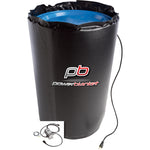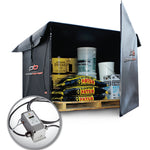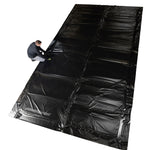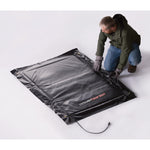You have no items in your shopping cart.
How Long Does it Take for Concrete to Dry?
Article At-a-Glance
How Long Does Concrete Take to Dry?
Concrete typically takes 24 to 48 hours to dry enough for foot traffic, but it requires about 28 days to fully cure and reach its maximum strength, with factors like temperature, humidity, and mix design affecting these timelines.
Key Takeaways
- Understand the Difference: Concrete drying and curing are distinct processes; drying allows the surface to harden for light use, while curing ensures the concrete reaches its full strength over time.
- Initial Drying Time: Concrete typically dries enough for foot traffic within 24 to 48 hours, but it should be kept clear of heavy equipment during this period.
- Full Curing Timeline: Achieving full strength takes about 28 days, with concrete reaching approximately 70% of its strength after 7 days.
- Influencing Factors: Drying and curing times can be affected by temperature, humidity, and the concrete mix design. Ideal conditions are between 50–60°F for optimal results.
- Speeding Up the Process: Techniques like using heaters, warm water, and curing blankets can accelerate drying and curing, but they must be used carefully to avoid compromising concrete integrity.
Concrete can take up to several days to dry. Is there anything you can do to speed up the drying process? Yes, there is! Read on to find out how.
What is concrete, and what are its main components?
Concrete is the most common man-made material in the world. It has existed in early forms long ago during the Roman era, when concrete was used in helping build mighty structures, some of which are still standing today. Modern concrete as we’ve come to use it came about in the 1800s with the creation of Portland cement, a binder used in holding the concrete mixture together.
Concrete is a mixture of water, sand, rocky aggregate, and Portland cement. The cement and water combination causes a chemical reaction that generates heat, bonding the sand and rocky aggregate together to form incredible strength. This binding process is known as curing.

The Christopher S. Bond Bridge is a cement bridge over the Missouri River in Kansas City, Missouri.
What is the difference between drying and curing?
Drying concrete and curing concrete are not the same thing. In fact, they’re actually two opposite terms, and it’s important not to mix them up.
Our friends at TRP Ready Mix have a simple description of the difference between drying and curing:
“Even though these two terms are often used in the same way and refer to moisture, they do not mean the same thing. Curing concrete means providing adequate moisture, temperature, and time that would help the concrete get the properties for the intended use. Drying, on the other hand, means providing the proper conditions to allow the concrete to achieve the appropriate moisture. So, in order to have a concrete floor you can easily walk on, you must both cure it and dry it.”
How does concrete dry, and how long does it take for it to be fully cured?
Concrete drying time is generally 24 to 48 hours. At this point, the neighborhood dog will not leave his footprints in it, but you should keep it clear of heavy equipment during this time period. By day 7, you should have concrete that is cured to 70% full strength or greater. Most mixes are cured at 28 days.

Concrete usually reaches 70% curing strength after 7 days.
The time it takes for concrete to be fully cured depends on the type of concrete, the weather, and the pour size. Concrete is strong in compression but weak in tension. To overcome this, reinforcement (usually steel) is added to concrete to increase its strength in tension.
What is the best temperature to pour concrete in?
The best temperature to pour concrete is between 50-60°F. Concrete can be poured and cured in nearly any outdoor temperature, but the fastest-drying and strongest-curing slabs are completed within the 50-60°F range. Workers often use fans and heaters indoors to maintain the ideal temperature for faster drying and curing.

Pouring concrete in cold temperatures can slow down drying time and the negatively impact the strength of concrete.
How can you tell if the concrete is dry enough to walk on or use for other purposes?
You can tell if the concrete is dry enough to walk on or use by checking the moisture level. Ensure the concrete is completely dry before walking on it or using it. Drying time can vary based on weather conditions and the mix design.
What factors affect the drying time of concrete?
Weather conditions can significantly impact the drying time of concrete. Factors like air temperature, humidity, wind, and precipitation all play a role:
- Air temperature: Concrete dries slower in temperatures below 50°F and can stop drying altogether below 40°F.
- Humidity: High humidity increases water concentration in the mix, which can lengthen drying time.
- Wind: Wind can cause uneven drying or blow debris onto the surface.
- Precipitation: Rain or snow can slow the drying process and destabilize the surface.
In addition to weather, the concrete mix design, including additives and water content, can also influence drying time.
How to make concrete dry faster
If 24 to 48 hours is too long, here are a few tips for speeding up drying time (though this can negatively affect curing):
- Use a heater to raise the temperature around the pour site.
- Use warm water in the concrete mix.
- Use less water in the mix (but not too little).


$1,915.99 USD
5’ x 20’ Multi-Duty Thawing & Concrete Curing Blanket (120V)
For faster curing and protection from the elements, consider using concrete curing blankets. These blankets provide heat to speed up the curing process while maintaining proper moisture levels for optimal concrete strength.
How to make concrete cure faster
Concrete cures faster under stable conditions, especially with added heat. Maintaining a steady temperature and using concrete curing blankets can speed up the process significantly.
Insulated tarps vs heating blankets for curing concrete
While insulated tarps maintain consistent temperatures during curing, they do not provide additional heat. Concrete curing blankets, on the other hand, supply direct heat through conduction, leading to faster curing times and better protection in cold weather.

Curing concrete with Powerblanket
Powerblanket curing blankets increase production by rapidly curing concrete with consistent, even heat.

Here are some benefits:
- Cure concrete 2.8 times faster than conventional insulated blankets
- Maintain moisture throughout the hydrating process
- Easily installed and removed
- Produce cold weather concreting strength of up to 3,925 psi in 72 hours
- Thaw ground and frost before pouring
- Reduce downtime & increase profitability
- Maintain ACI compliance for cold weather concreting
See which concrete blankets are right for you or contact our team to learn more.
Frequently Asked Questions About Concrete
What is concrete?
Concrete is a mixture of cement, sand, and aggregate. When mixed with water, it hardens and can hold substantial loads for long periods of time.
Is concrete made from rocks?
Yes, concrete is made from a binder (cement), sand, and small rocks (aggregate).
Can I pour concrete in cold weather?
Yes, but using heating blankets helps it cure properly in cold weather.
Is it OK if it rains after pouring concrete?
Rain should not affect properly set concrete after a few days, but avoid pouring concrete in wet conditions.
Can you add dyes to concrete to change the color?
Yes, various dyes or pigments can be added to wet concrete to alter its color.
How long does concrete last?
Properly maintained concrete can last for decades, if not centuries, even in harsh conditions.













